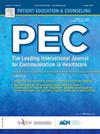A description of the development and initial evaluation of a patient navigator delivered patient portal enrollment program
IF 3.1
2区 医学
Q2 PUBLIC, ENVIRONMENTAL & OCCUPATIONAL HEALTH
引用次数: 0
Abstract
Objectives
Uptake of electronic patient portals is low in underserved populations. Federally qualified health centers (FQHCs) face unique barriers, including limited digital literacy, language differences, and low trust in technology. This paper describes the development and initial evaluation of a patient navigator program aimed at increasing portal enrollment in three FQHC locations.
Methods
Development and implementation followed a seven-step process guided by the Knowledge to Action Framework: (1) stakeholder engagement to identify barriers, (2) literature review to contextualize disparities, (3) resource and workflow assessment, (4) stakeholder feedback to refine the navigator approach, (5) a monitoring system to track enrollment and navigator activities, (6) identification of structural barriers and sustainability strategies, and (7) project evaluation. Navigators were embedded in clinic workflows to assist with MyChart enrollment, provide technical help, and address concerns. Activation rates were assessed with pre-post comparisons and navigator tracking data.
Results
Tailored materials, including a MyChart handout and a smaller flyer for login details, were created. Over 12 months, of 1658 eligible patients, 1062 (64 %) accepted navigator assistance; 790 (74 %) successfully activated MyChart. African American (44 % to 49 %) and Latinx (52 % to 60 %) patients showed notable gains, and nearly all (99 %) newly enrolled users accessed MyChart at least once post-activation.
Conclusions
Embedding navigators proved feasible for increasing MyChart enrollment in FQHC settings. The structured process highlighted essential considerations for scalability. Future work should examine long-term sustainability and how patient navigation affects broader engagement and health outcomes.
Practice implications
By offering real-time, culturally attuned support, navigators can help patients overcome digital literacy barriers, thereby improving enrollment in patient portals. Health systems seeking to reduce disparities may benefit from adopting navigator-led strategies as part of routine care.
介绍了患者导航器的开发和初步评估,提供了患者门户注册计划
目的在医疗服务不足的人群中,电子患者门户的使用率很低。联邦合格医疗中心(FQHCs)面临着独特的障碍,包括有限的数字素养、语言差异和对技术的低信任度。本文描述了旨在增加三个FQHC地点门户注册的患者导航程序的开发和初步评估。方法:在知识到行动框架的指导下,开发和实施遵循七个步骤的过程:(1)利益相关者参与以识别障碍;(2)文献综述以将差异置于背景下;(3)资源和工作流程评估;(4)利益相关者反馈以完善导航方法;(5)跟踪招生和导航活动的监测系统;(6)识别结构性障碍和可持续性战略;(7)项目评估。导航器被嵌入到诊所工作流程中,以协助MyChart注册、提供技术帮助和解决问题。通过前后比较和导航器跟踪数据评估激活率。结果创建了定制的材料,包括MyChart讲义和登录详细信息的较小传单。在12个月的时间里,在1658名符合条件的患者中,1062名(64% %)接受了导航辅助;790(74 %)成功激活MyChart。非裔美国人(44% %至49% %)和拉丁裔(52% %至60 %)患者表现出显著的改善,几乎所有(99 %)新注册用户在激活后至少访问过一次MyChart。结论在FQHC环境下,使用导航器增加MyChart入组是可行的。结构化流程强调了可伸缩性的基本考虑。未来的工作应该研究长期的可持续性,以及患者导航如何影响更广泛的参与和健康结果。通过提供实时的、与文化相适应的支持,导航器可以帮助患者克服数字素养障碍,从而提高患者门户网站的注册率。寻求缩小差距的卫生系统可能会受益于将导航员主导的战略作为常规护理的一部分。
本文章由计算机程序翻译,如有差异,请以英文原文为准。
求助全文
约1分钟内获得全文
求助全文
来源期刊

Patient Education and Counseling
医学-公共卫生、环境卫生与职业卫生
CiteScore
5.60
自引率
11.40%
发文量
384
审稿时长
46 days
期刊介绍:
Patient Education and Counseling is an interdisciplinary, international journal for patient education and health promotion researchers, managers and clinicians. The journal seeks to explore and elucidate the educational, counseling and communication models in health care. Its aim is to provide a forum for fundamental as well as applied research, and to promote the study of organizational issues involved with the delivery of patient education, counseling, health promotion services and training models in improving communication between providers and patients.
 求助内容:
求助内容: 应助结果提醒方式:
应助结果提醒方式:


